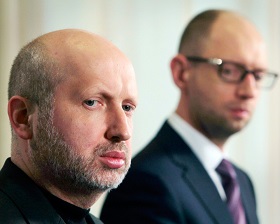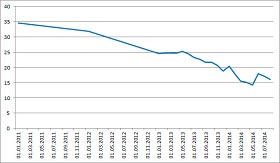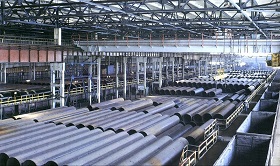Political Implications of Economic Suicide
Ukrainian Prime Minister Arseny Yatseniuk
speaks during a news conference in Kiev,
July 28, 2014
(no votes) |
(0 votes) |
President of the Center for Systems Analysis and Forecasting, Ukraine
The economic policy that the Ukrainian government has pursued over the six months since the armed coup on February 21-23, 2014 is aimed at breaking existing economic ties with Russia (without offering an adequate alternative) and appears to be absolutely suicidal (both to the country’s economy and the existence of the state). There is no explanation for the policy in terms of economic interests. This is a political decision made within the framework of the declared policy of "European integration” and in fact is an illustration of the country submissively following in the footsteps of US foreign policy.
The economic policy that the Ukrainian government has pursued over the six months since the armed coup on February 21-23, 2014 is aimed at breaking existing economic ties with Russia (without offering an adequate alternative) and appears to be absolutely suicidal (both to the country’s economy and the existence of the state). There is no explanation for the policy in terms of economic interests. This is a political decision made within the framework of the declared policy of "European integration” and in fact is an illustration of the country submissively following in the footsteps of US foreign policy.
The Political Context of Economic Problems
A dynamic economy forms the basis of political stability, sustainable development and military security of any state, irrespective of foreign policy orientation, political regime and the degree of societal consolidation. Only a functioning economy can supply a national budget sufficient for the state to perform its functions, namely financing the state apparatus and social sector needs, as well as investing in promising projects.
From this perspective, the Ukrainian state was not viable back in February 2014. On February 24, the newly appointed Speaker of the Verkhovna Rada and government coordinator (future Acting President of Ukraine) Alexander Turchinov declared in Parliament that Ukraine needed external financing of 35-40 billion dollars before the end of 2014. On the same day A. Turchynov, together with the National Bank of Ukraine and the Ministry of Finance, addressed a request to “Ukraine's Western partners” for macro-financial assistance "within a week or two”. To adequately assess the volume of financial assistance urgently requested by Ukraine, it should be noted that the 2014 national budget of Ukraine was adopted under the respective Law on January 16, 2014 (that is, just six weeks earlier) with revenue of UAH 395.3 billion (approximately $47 billion under the exchange rate at that time or about 33 billion dollars at the exchange rate at the end of August 2014). The Ukrainian politicians who had just seized power asked for outside financing at an amount which was close to the size of budget revenues. This means that they were not counting on tax revenues from a normally functioning Ukrainian economy.
The Ukrainian politicians who had just seized power asked for outside financing at an amount which was close to the size of budget revenues. This means that they were not counting on tax revenues from a normally functioning Ukrainian economy.
It should be emphasized that the start of full-scale civil war in Ukraine was two months away, and the first peaceful mass protests against the regime began in Crimea and in the Southeast only a week later. In other words, the government actually expected an economic collapse during peacetime. At that time, this event passed practically unnoticed. And even now few people remember the urgent pleas from Ukrainian “Eurointegrators” to Europe and the United States to finance the budget of Ukraine to the fullest extent possible. At the time of the request for $35 billion in “macro-financial assistance,” Ukraine was already two months into 2014. Therefore, the requested amount was asked for the remaining 10 months. In February, the International Institute of Finance (IIF) projected a reduction in gold and foreign currency reserves of Ukraine down to 12 billion dollars (compared to 16 billion dollars in January), and analysts warned about the strong possibility or even inevitability of default. By the end of January 2014, the volume of production dropped by 5 percent on an annualized basis, the International Monetary Fund predicted a 5 percent drop in GDP for the year, while the European Bank for Reconstruction and Development put the number 7 percent (1, 2). And in its forecast, the IMF operated from the assumption that Ukraine would maintain access to the Russian market.
It would seem that under such conditions, the government would seize the opportunity to improve or at least stabilize the economic situation. However, the Ukrainian government did exactly the opposite. In March 2014, it demanded that Russia reduce the gas price to a level “acceptable for Ukraine” (by almost halving it), otherwise refusing to pay billions of dollars in debt already accumulated. Negotiations continued until mid-June and yielded no results. Eventually, Russia suspended gas supplies to Ukraine.
The Ukrainian government put on a show of bravado, threatening to solve the gas problem by reverse gas flows, and at the same time introduced austerity measures. In Kiev, the hot water supply was cut off in more than 50 percent of homes “until the start of the heating season” (October 15), but in reality for an indefinite term. Televised ads on the main channels urged citizens to “pull the plugs from the wall outlets”, “light candles” instead of turning on lamps, make homes coldproof, etc. The Ukrainian authorities do not expect to solve the gas problem before the weather gets cold.
Since there is intense fighting in the main coal-mining region of Ukraine Donbass, more than half the mines have ceased to operate, and the rest might stop functioning at any time. Compared to July 2013, coal production in July 2014 fell by 21.6 percent. Housing maintenance and utilities of Ukraine are facing fuel starvation. There is little doubt that people will try to solve the problem of a lack of hot water and the low temperature of radiators by means of boilers and electric radiators, which, in turn, will result in an overload of power supply networks and rotational power cutoffs.
During winter Kiev will have to choose between three evils. It can either use all available gas for household needs to the detriment of existing industry, or supply gas to industry and risk the danger of sparking riots among the freezing population, or illegally collect gas from transit flows intended for European consumers.
The collapse of the housing and communal services in the winter threatens to destabilize the situation in large cities. According to the most optimistic estimates, the gas reserves in storage (processing gas excluded) are at the level of 15 billion cubic meters. It means that during winter Kiev will have to choose between three evils. It can either use all available gas for household needs to the detriment of existing industry, or supply gas to industry and risk the danger of sparking riots among the freezing population, or illegally collect gas from transit flows intended for European consumers. However, should the latter scenario occur, Gazprom can close or drastically reduce the gas for Ukrainian transit, as it did during the gas war in 2009. This will only deteriorate Ukraine-EU relations and is unlikely to do any good for Ukraine.
The Critical State of Basic Industries
The unresolved gas problem per se is fraught with the complete collapse of the remnants of the Ukrainian industry, and it is hard to say which aspect of it is more disastrous – energy or the social sector. Indeed, during a period of social unrest, people are on the barricades, and not in factories. Meanwhile, if some other energy source could at least theoretically be used instead of gas, it’s impossible to imagine who could replace workers on-site.
It must be taken into account, that gas is the raw material for the chemical and petrochemical industries. Gas and coking coal are necessary for the operations of iron and steel enterprises. The chemical, petrochemical and metallurgical industries account for 60 percent of foreign currency earnings in Ukraine.
Machine building is another basic sector of the Ukrainian economy. Already in March 2014, the Ukrainian government blocked exports to Russia of certain products for the military-industrial complex (e.g. helicopter engines produced by the Motor Sich JSC). On August 8, Ukraine stopped cooperation not only in the sphere of the defense industry, but also related to dual-use goods. This development affected all engineering products, the major buyers of which are Russia (40 percent of total engineering exports of Ukraine), CIS countries, China, Iraq and Thailand (97 percent together with Russia). Finding new markets for such a volume of specific products, designed for the individual consumer, appears unfeasible.
The unresolved gas problem per se is fraught with the complete collapse of the remnants of the Ukrainian industry, and it is hard to say which aspect of it is more disastrous – energy or the social sector.
The issue at hand is not just the refusal of Ukraine to supply turbines for warships, helicopter engines and missile guidance systems, but also the ban on supplying pipes (the Khartsyz pipe factory stopped operations), wagons, locomotives, etc. The end of cooperation in the defense industry and in engineering will not inflict critical damage on Russia. First, Moscow has long been implementing a program of strategic transfer of production (from Ukraine as well), associated primarily with the defense industry, to its territory. Second, virtually the entire product mix supplied by Ukraine can be purchased from other producers. Thus, while launching its own production, Russia can buy engines for its helicopters from France and ship turbines from Italy. The Italians and the French have made sure that the sanctions imposed by the EU do not apply to their military-technical cooperation with Russia (the sanctions will not impact the delivery of Mistral helicopter carriers). At the same time, Ukrainian defense industry enterprises have no other market than the Russian one. Meanwhile, the enterprises of the military-industrial complex and associated production make up another 20 percent of the budget and cannot reorient to the domestic market. The budget for the current year (just as the budgets of all 23 years of the Ukrainian independence) traditionally allocates no money for purchasing weapons for the army, but the Ukrainian armed forces do not need such items and in such quantities (Ukraine, for example, does not produce helicopters itself and gets them from Russia in exchange for helicopter engines). Up until now, the Ukrainian army purchased only ten T-80 tanks and several armored personnel carriers.
Over the next 12 months, companies in the Ukrainian military-industrial complex and machine building in general that fail to transfer their production to Russia, will stop operations; reviving them will be impossible. The only hope lies in the fact that the current Kiev regime will not last that long and some things could be salvaged.
According to the State Statistics Committee of Ukraine, agriculture appears to be the only sector of the economy that showed moderate growth in the first eight months of 2014. However, like the rest of the Ukrainian economy, agriculture has been faced with a permanent crisis for more than a year. Compared with the Soviet period, the volume of production in all the main groups, except grain, has dropped drastically, while labor productivity has also significantly fallen. Ukrainian agriculture is focused on export crops, namely corn, rape and sunflower seeds. At the same time, Ukraine is not self-sufficient in meat and meat products, fish and marine products, fruits and berries. More generally, Ukrainian agriculture, satisfying the needs of the favored few (mostly foreign) corn traders, fails to provide decent living standards for the rural population (petty farmers with their families number 14 million people), and to fill the state budget.
The Inevitable Financial and Economic Collapse
The financial and banking sector cannot function properly if the economy is in crisis, the budget is empty and gold and foreign currency reserves dwindle. Moreover, the efforts of the National Bank of Ukraine to stabilize the economy inspire little if any optimism among experts. The external funding of 35 billion dollars requested by Kiev could have helped to stabilize the public finances. It would not have averted economic collapse, but could help the government soften the consequences for the population, making them nearly unnoticeable in 2014. However, over the six months that have passed since the armed revolution, the government has managed to obtain only about $6 billion in loans and aid from the IMF, the EBRD, the United States, the EU and individual European countries. The IMF may provide another 1.5 billion dollars in September, although this is not yet certain. Apparently, there will be no other income until the end of the year. The minimum requirements of Ukraine will be financed only by a quarter. And these minimum requirements were determined before the loss of the Crimea and the civil war. Now Kiev now has not only to finance the war, but has lost revenues from enterprises in the Southeast that have been destroyed by Ukrainian troops’ bombing and shelling. These enterprises used to be the major donors to the budget.
The Ukrainian state is bankrupt on its own accord. All decisions that created this crisis in industry and the energy sector were political in nature and pursued the goal of provoking confrontation with Russia.

A. Yatsenyuk’s initiative to place on unpaid vacation 90 percent of civil servants, the failure of the state to pay combatants their wages in compliance with the law and even forcing mobilized civilians to cover the equipment expenses of their military illustrates the critical state of public finances.
The Ukrainian state is bankrupt on its own accord. All decisions that created this crisis in industry and the energy sector were political in nature and pursued the goal of provoking confrontation with Russia. Moscow was ready to constructively discuss any issue, and it even agreed to nearly halve the price for gas, supplied to Ukraine. It did not close its markets to Ukrainian goods even after Kiev signed the Association Agreement with the EU that established the Deep and Comprehensive Free Trade Area between Ukraine and the EU. Kiev deliberately and bluntly blocked all negotiations and severed economic ties. Coupled with the Ukrainian authorities’ constantly instigating military conflict with Russia (up to and including the shelling of the Russian territory), these actions serve the interests of only one global actor, namely Washington. It is easy to assume that the United States makes use of the Ukrainian leadership which it is completely controlling to prevent potential cooperation between Russia and the EU (within the framework of the EU-Customs Union free trade area stretching from the Atlantic Ocean to the Pacific Ocean) which would challenge not only the economic, but the military and political hegemony of the US as well.
Kiev is committing economic suicide that will inevitably lead to the collapse of the Ukrainian state and does it exclusively in the interests of the United States. However, the American victory over Russia or the defeat in the Ukrainian crisis will change nothing for Ukraine, since the latter is regarded by Washington as expendable material. Assistance is not being delivered to save Ukrainian statehood and is measured out in doses to extend its collapse for as long as possible, so that Russian resources are tied up and Washington has room for maneuver. But the United States is not going to overpay. The state of the Ukrainian economy and the amount of financial assistance from the West indicate that Washington does not view Ukraine beyond 2014. And this is the final political outcome of Kiev’s voluntary economic suicide.
(no votes) |
(0 votes) |







